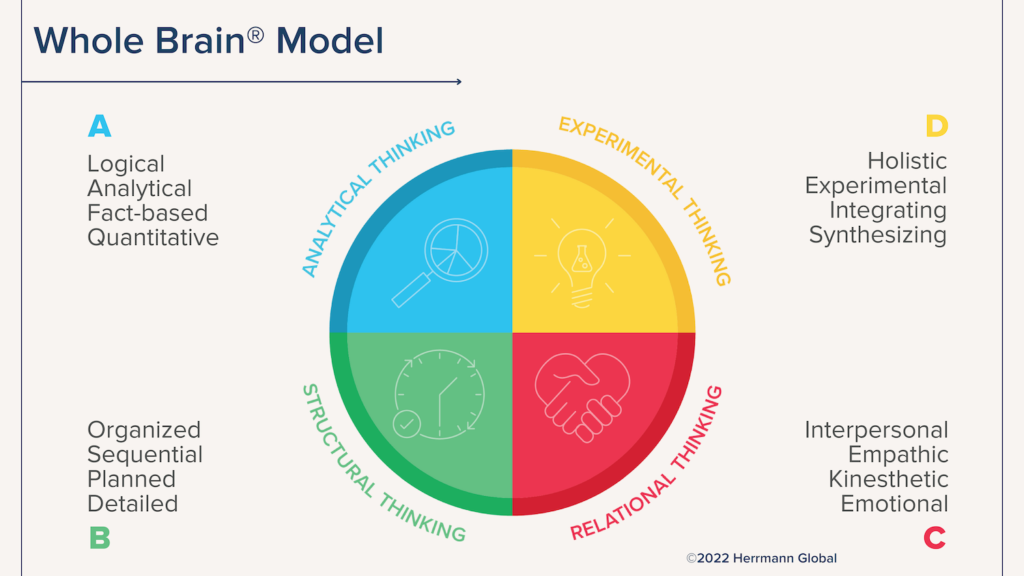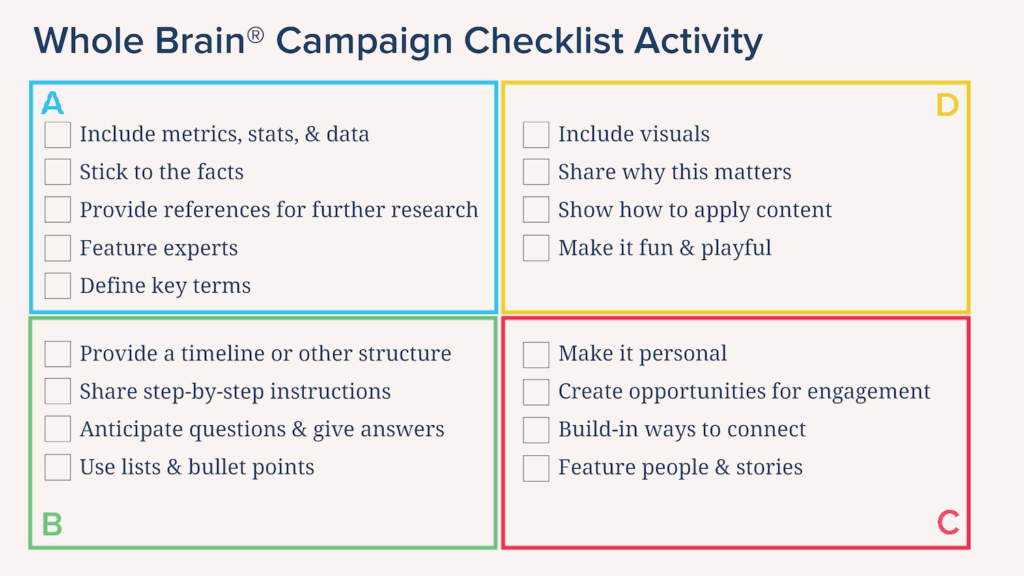Content marketing is all about connecting with your audience. But to do that, you need to understand your audience’s perspective.
One way to learn what your audience is thinking is by using Herrmann International’s Whole Brain® Thinking framework, which helps teams understand and embrace different thinking preferences to improve their team’s intelligence, eliminate strategic blind spots and harness cognitive diversity in the flow of work. .
We asked Ashley Blackburn, head of content at Herrmann, to join us at the Managing Editor LIVE Fall Summit to share how to apply this powerful cognitive diversity model to content marketing. Read on for highlights of her workshop, “Use Your Whole Brain to Ignite Demand.”
Consider Your Audience’s Thinking Preferences — Not Just Your Own
Whole Brain® Thinking provides a lens for understanding and capitalizing on people’s unique thinking preferences. The model has four quadrants of thinking, and there’s no one “correct” or idea quadrant:
- Analytical (Blue): Thinkers with a blue preference tend towards logical, fact-based and quantitative thinking. They examine how things work and weigh the pros and cons of each situation.
- Structural or Safe-Keeping (Green): People with a preference for the green quadrant prioritize planning, organizing and sequencing information. They tend to think through decisions sequentially and want a step-by-step breakdown of the processes they use.
- Relational or Feeling (Red): Thinkers with a red preference prioritize interpersonal, emotional and kinesthetic activities. They think about how people will feel and want to make everyone feel comfortable.
- Experimental (Yellow): People with a preference for the yellow quadrant look for the “why” in every situation. They enjoy connecting ideas and thinking outside the box.
The Herrmann Brain Dominance Instrument (HBDI) assesses an individual’s thinking preferences based on this model by measuring those four different thinking styles to determine an individual’s predominant preference. This insight can then be used to inform the way each person approaches tasks and interacts with their colleagues.
And, it turns out, how we create content that appeals to them, according to Ashley.
“I’m a really high yellow thinker and a really low blue thinker. So when I’m putting something together for an audience that I anticipate is going to be high blue, that’s a blind spot for me,” Ashley says. “So I have to ensure that I’m including stats and facts, I’m providing metrics and references, and we’re talking about the bottom line.”
Understanding the differences between your thinking style and other people’s can help you prevent miscommunication and deliver more powerful and targeted messaging. “Speak to them in their own language and address them in a way that will feel right to them because we’re talking to them in their own thinking preferences.”
Whole Brain Thinking helps us think about the impact of our work, not just whether we and our teammates love it. After all, she adds, “it’s not what content marketers create that counts but what ‘clicks’ with people.”

Build Well-Rounded Teams With Different Thinking Styles
Understanding your Whole Brain Thinking preferences can help everyone on your content marketing team elevate their thinking and learn how to collaborate better.
We tend to default to our thinking preferences. The challenge for content marketing leaders is to understand their own thinking and build teams that are cognitively diverse..
Ashley walked through a few roles within content marketing departments where different thinking styles often present themselves.
Project Management
Project managers are likely to have higher preferences in structural (green) and analytical (blue) thinking because of the nature of their work, Ashley says. And while they like working with people, they’re probably a little bit lower on the yellow. “They’re going to be more interested in keeping things on track and sticking to a sequence.”
Data Analysis
Data analysis is part of everyone’s job these days, Ashley notes, although some teams have dedicated analysts. People who love this work are highly analytical (blue) and might also have a high green preference because of the structure involved.
Visual Design
Visual thinkers generally have high yellow preferences because they like to think in pictures; they like to see illustrations and animation, Ashley says. These thinkers can have any mix of blue, green and red preferences, too, adding to their versatility within your team.
Content Strategy
The challenge facing these people, Ashley notes, is that they have to do a little bit of everything: Think outside the box, talk through concepts, develop a strategy, and evaluate results. Content strategists have a wide variety of preferences.

Put Thinking Preferences Into Action
As you plan your next content marketing campaign, consider how your thinking preferences inform your work. Contrast those preferences with what your audiences want and need. You might find yourself making adjustments that initially feel uncomfortable, because they go against your personal thinking preferences, but stick with it.
Ashley also points out that thinking preferences aren’t always connected to a person’s skills. “So you could be really good at numbers but not like them. Or you could be really good at managing projects. But if that’s a lower preference for you, then it might take you more energy, more time, you have to sink into that headspace a little bit.”
And you don’t have to go it alone. We all have blind spots if we try and tackle all of those different functions by ourselves. “It’s a great case for bringing other people into the work, because they’re going to round out your team.”






